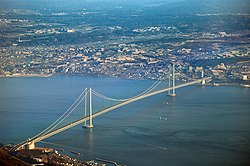Akashi Kaikyo Bridge
Akashi Kaikyō Bridge Akashi Kaikyō Ō-hashi (明石海峡大橋) | |
|---|---|
 Akashi Kaikyō Bridge from the air | |
| Coordinates | 34°36′59″N 135°01′13″E / 34.61639°N 135.02028°E |
| Carries | six lanes of roadway |
| Crosses | Akashi Strait[1] |
| Locale | Awaji Island and Kobe[1] |
| Other name(s) | Pearl bridge |
| Maintained by | Honshu-Shikoku Bridge Authority |
| Characteristics | |
| Design | Suspension bridge[1] |
| Total length | 3,910 meters (12,830 feet) |
| Height | 282.8 metres (928 ft) (pylons)[1] |
| Longest span | 1,990 meters (6,530feet)[1] |
| Clearance below | 65.72 metres |
| History | |
| Construction start | 1988[1] |
| Construction end | 1998[1] |
| Opened | April 5, 1998 |
| Statistics | |
| Toll | ¥2,300 |
| Location | |
 | |
The Akashi-Kaikyō Bridge (明石海峡大橋, Akashi Kaikyō Ō-hashi), also known as the Pearl Bridge, has the longest central span of any suspension bridge,[2] at 1,990 metres (6,529 ft). It is located in Japan and it was completed in 1998 after a decade of construction work.[1] The bridge links the city of Kobe on the island of Honshu to Iwaya on Awaji Island by crossing the busy Akashi Strait. This bridge provides part of the Honshu-Shikoku Highway.
This bridge is one of the key links of the Honshū-Shikoku Bridge Project, which created three highways across the Inland Sea of Japan.
History
Before the Akashi Kaikyō Bridge was completed, ferries carried passengers, cargo, and cars across the Akashi Strait. This dangerous waterway often suffers from severe storms and in 1955, two ferries sank in the strait during a huge storm. 168 people on board were killed. The ensuing shock and public outrage convinced the Japanese government to develop a plan for suspension bridges to cross the strait.
The original plans called for a mixed railroad-highway bridge, but when the construction on the bridge began in April 1988, the plans had been changed to a highway bridge only, six lanes wide. The actual construction work began in May 1988, and after a decade of work, this bridge was opened to traffic on April 5, 1998.[3] The Akashi Strait is an international waterway that called for a 1,500-metre (4,921 ft)-wide shipping channel.
Architecture

The bridge has three spans. The central span is 1,991 m (6,532 ft) long,[1] and the two side spans are each 960 m (3,150 ft) long. The bridge is about 3,910 m (12,828 ft) long overall.
Its two suspension towers were originally 1,990 m (6,529 ft) apart, but the Great Hanshin earthquake on January 17, 1995, moved the towers so that (with only one tower having been erected at the time) that the length of the central span had to be increased by 1 m (3.3 ft).[1]
This suspension bridge was designed with a two hinged stiffening girder system, allowing the structure to withstand winds of 286 kilometres per hour (178 mph), earthquakes measuring to 8.5 on the Richter scale, and harsh sea currents. The bridge also contains pendulums that are designed to operate at the resonance frequency of the bridge to dampen forces. The two main supporting towers rise 282.8 m (928 ft) above sea level, and the bridge can expand because of heat by up to 2 m (7 ft) over the course of a day. Each anchorage required 350,000 tonnes (390,000 tons) of concrete. The steel cables have 300,000 kilometres (190,000 mi) of wire: each cable is 112 centimetres (44 in) in diameter and contains 36,830 strands of wire.[2][4]
The Akashi-Kaikyo bridge has a total of 1,737 illumination lights: 1,084 for the main cables, 116 for the main towers, 405 for the girders, and 132 for the anchorages. On the main cables three high light discharged tubes are mounted in the colors red, green and blue. The RGB color scheme and computer technology make for a variety of combinations. Currently, 28 patterns are used for occasions as national or regional holidays, memorial days or festivities.[citation needed]
Use
The total cost is estimated at 500 billion yen, and that is expected to be repaid by charging vehicles toll to cross the bridge. The toll is 2,300 yen, as of 2012, and the bridge is used by about 23,000 [[automobile]s and trucks per day.[5]
Nearby attractions
Two parks in proximity to the bridge have been built for tourists, one in Maiko (including a small museum) and one in Asagiri. Both are accessible by the coastal train line.
See also
- Great Seto Bridge
- Honshū-Shikoku Bridge Project
- Kurushima-Kaikyo Bridge
- List of longest suspension bridges
References
- ^ a b c d e f g h i j Akashi Kaikyo Bridge at Structurae
- ^ a b Akashi Kaikyo Bridge
- ^ Cooper, James D. "World's Longest Suspension Bridge Opens in Japan". United States Department of Transportation - Federal Highway Administration. Retrieved 14 February 2012.
- ^ Supporting the Longest Suspension Bridge in the World
- ^ Megastructures. National Geographic for Channel Five.

